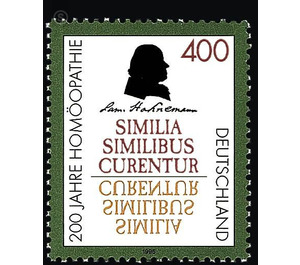200 years homeopathy - Germany / Federal Republic of Germany 1996 - 400 Pfennig
Theme: Health & Human
| Country | Germany / Federal Republic of Germany |
| Issue Date | 1996 |
| Face Value | 400.00 |
| Color | green white |
| Perforation | K 13 3/4: 14 |
| Printing Type | Multicolor offset printing |
| Stamp Type | Postage stamp |
| Item Type | Stamp |
| Chronological Issue Number | 1753 |
| Chronological Chapter | GER-BRD |
| SID | 206873 |
| In 29 Wishlists | |
In 1796, an essay by the Saxon physician Samuel Hahnemann (1755-1843) appeared in one of the most renowned medical journals in Germany under the title "Attempt at finding a new principle for finding the healing powers of the drugs, along with a few glimpses of the previous ones". Hahnemann, who had already made a name for himself as a doctor and pharmacist, developed the basic features of the so-called similarity rule "Similia Similibus Curentur" in this essay. According to her, diseases can be cured with the substances that can cause symptoms similar to those of healthy people. In his research, Hahnemann later recognized that the smallest drugs often had a much stronger effect than large ones. From these observations, he developed the principle of potentized, effective by dilution remedies, which are still used in homeopathic therapy. Homeopathy quickly became known in the 19th century and was first spread by Hahnemann's students in Europe and soon worldwide. From the beginning, however, homeopathy was also exposed to sharp attacks from "conventional medicine". Their criticism aims to the present day that the mechanisms of action homeopathic, i. potentiated drugs, can not be scientifically explained. However, the obvious therapeutic successes of homeopathy and growing skepticism towards conventional medicine have led to more and more patients worldwide entrusting themselves to this 200-year-old medical science. (Text: German Hygiene Museum, Dresden)


